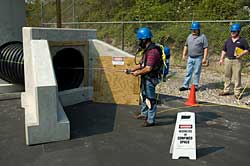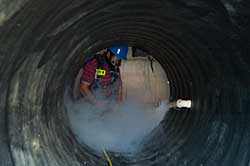
Entering Unforgiving Territory
Disregarding the importance of proper training in confined space entry could cost you your life.
- By Chris Lange
- Oct 31, 2007
 The day began like any other for an experienced contractor of 15 years. He left his house at 7 a.m. to perform storage tank maintenance at a local chemical plant. This was a very routine task, one he had performed hundreds of times. As he kissed his wife and two young children goodbye, he anticipated being done early this day and told them that he would see them for dinner. As he backed his car down the driveway, he honked the horn and waved goodbye. Sadly, this was the last time he would ever see his family.
The day began like any other for an experienced contractor of 15 years. He left his house at 7 a.m. to perform storage tank maintenance at a local chemical plant. This was a very routine task, one he had performed hundreds of times. As he kissed his wife and two young children goodbye, he anticipated being done early this day and told them that he would see them for dinner. As he backed his car down the driveway, he honked the horn and waved goodbye. Sadly, this was the last time he would ever see his family.
How It Happened
The job at hand on this day required cleaning two inches of dried crude oil from the bottom of a storage tank. Dried product also clung to the ceiling and required removal by grinding. The steel tank was 45 feet in diameter and 90 feet tall, with access through an external enclosed ladder. The worker and a coworker arrived at the storage tank and prepared to perform the required maintenance. They planned for one of them to descend into the tank and complete the job while the other remained at the entrance in case of an emergency.
As they exited the vehicle, a call came in requiring one of them to respond to a more urgent matter at another location. The worker who remained assured his coworker that he could perform this maintenance on his own. After all, he had done this many times before and was no rookie. Reluctantly, the coworker agreed and left to respond to the more urgent matter. The remaining worker proceeded to descend 90 feet into the steel storage tank.
Later that evening, the company office received a report that the worker had not arrived home for dinner. It should also be noted that the worker did not phone the office to report any unusual situation.
The coworker who originally was scheduled to work the job and another person returned to the site. They found the company truck in the same location it was earlier in the day and made a 911 call for assistance. After repeated attempts to get a human response from inside the tank, both workers entered the tank and climbed down the ladder.
A short time later, a rescue team found three workers lying on the floor of the tank. An investigation determined that their cause of death was asphyxiation due to oxygen deficiency. Oxygen levels within the tank were measured at less than 6 percent in some areas. Normal oxygen levels are approximately 21 percent.
The minimum safe level set by the Occupational Safety and Health Administration and the National Institute for Occupational Safety and Health is 19.5 percent. At levels below 6 percent, convulsive movement and gasping respiration occurs, then respiration stops, and minutes later heart action ceases. Life expectancy is 3 to 5 minutes.
Although the situation described here is fictitious, similar events happen far too often, even though they are avoidable. This situation also illustrates the disturbing OSHA statistic that would-be rescuers make up 60 percent of confined space fatalities. In this case, they reacted based on an impulsive desire to help immediately rather than on a rational and thoughtful plan.
A simple, basic training course in confined space entry could have prevented the loss of three lives. With the abundance of training options available today, there's no reason that proper training in confined space entry applications should ever be overlooked.
Sharing Best Practices
Today, there are more options available than ever before for sharing best practices with peers and obtaining the proper training needed to perform safe confined space entries, all of which will greatly diminish the risks involved with confined space work. One of the most important benefits of training involves an increased awareness of the potential dangers. A variety of training options from safety equipment manufacturers and training companies are available--from video, online and, computer-based training to classroom sessions and hands-on learning.
First, you should understand what kind of potential hazards may be at your job site. Become familiar with OSHA standards, and develop a working knowledge of their terms and definitions. Taking these first steps will greatly reduce the risk of a catastrophic situation. Reviewing OSHA's confined space standard 29 CFR 1910.146 at www.osha.gov will provide a blueprint for the proper procedures and practices at the heart of any confined space program. Many, if not all, mistakes in confined space programs could be decreased or eliminated altogether if safety managers and workers simply followed OSHA's standards and recommendations.
After determining the hazards at your location and becoming familiar with OSHA standards, one of the most effective tools to ensure true-to-life training is to enroll in a confined space entry class that combines theory with practical hands-on exercises. The class should offer in-depth theoretical training on gas hazards, regulations, and procedures. It also should cover the necessary safety equipment and personnel required to perform a safe confined space entry. However, a trainer with an in-house confined space simulator will provide the most practical and beneficial experience to prepare the trainee for real-world applications. Remember, we all learn better by doing.
The Benefits of Hands-on Training
Confined space simulators allow students to put their training to the test with actual confined space entry scenarios. Activities include pre-entry tests as well as horizontal and vertical entries in such confined spaces as storage tanks, wells, vats, boilers, and manholes. Simulators can also be equipped to add theatrical smoke to show how gas stratifies within a space, or how it is eliminated with ventilation.
At the conclusion of the exercises, the trainer reviews all actions and recommends corrective actions if necessary. Common to competency-certified classes, final exams can test the skills acquired during training in the critical areas of confined space entry. Trainees who successfully pass the exam can earn competency certifications good for one or two years.
It is very important to remember that practice makes perfect. The ultimate benefit of such training is to provide a clear vision of how to properly perform confined space entry and make your company a safer place to work. If the skills acquired during the training are not reinforced with continual, practical hands-on exercises and review of OSHA standards, they will be lost. Commit to regularly scheduled refresher training to ensure that you retain all skill sets required to perform a safe confined space entry.
Confined spaces can be unforgiving places to work. Unfortunately, periodic entry is necessary. A systematic approach to each and every entry will help ensure worker safety from entry to egress. Planning, preparation, and training are the keys to ensuring safe passage in these varied environments.
Familiarity, complacency, and a false sense of security can all lead to abandoning best practices, especially when the time spent working in the space is expected to be minimal. But trained workers know that accidents can happen to anybody at any time. No matter how much time is spent working in the space, the potential danger remains the same.
Don't Become a Statistic
The U.S. Department of Labor's Bureau of Labor Statistics states that an average of 96 fatalities occurred annually between 1992 and 2002 due to oxygen-deficient atmospheres. The results of a 10-year study performed by OSHA showed that 43 percent of confined space atmospheric hazard deaths were due to oxygen deficiency: 40 percent of deaths involved repair/maintenance jobs, 38.6 percent of deaths occurred in tanks, and 25 percent of deaths occurred within the municipal industry.
Statistics do not lie. Disregarding the importance of proper training in confined space entry could cost you your life. Don't become a statistic! Take the necessary steps today and prepare yourself to stay alive the next time you are called upon to perform a confined space entry.
This article originally appeared in the November 2007 issue of Occupational Health & Safety.